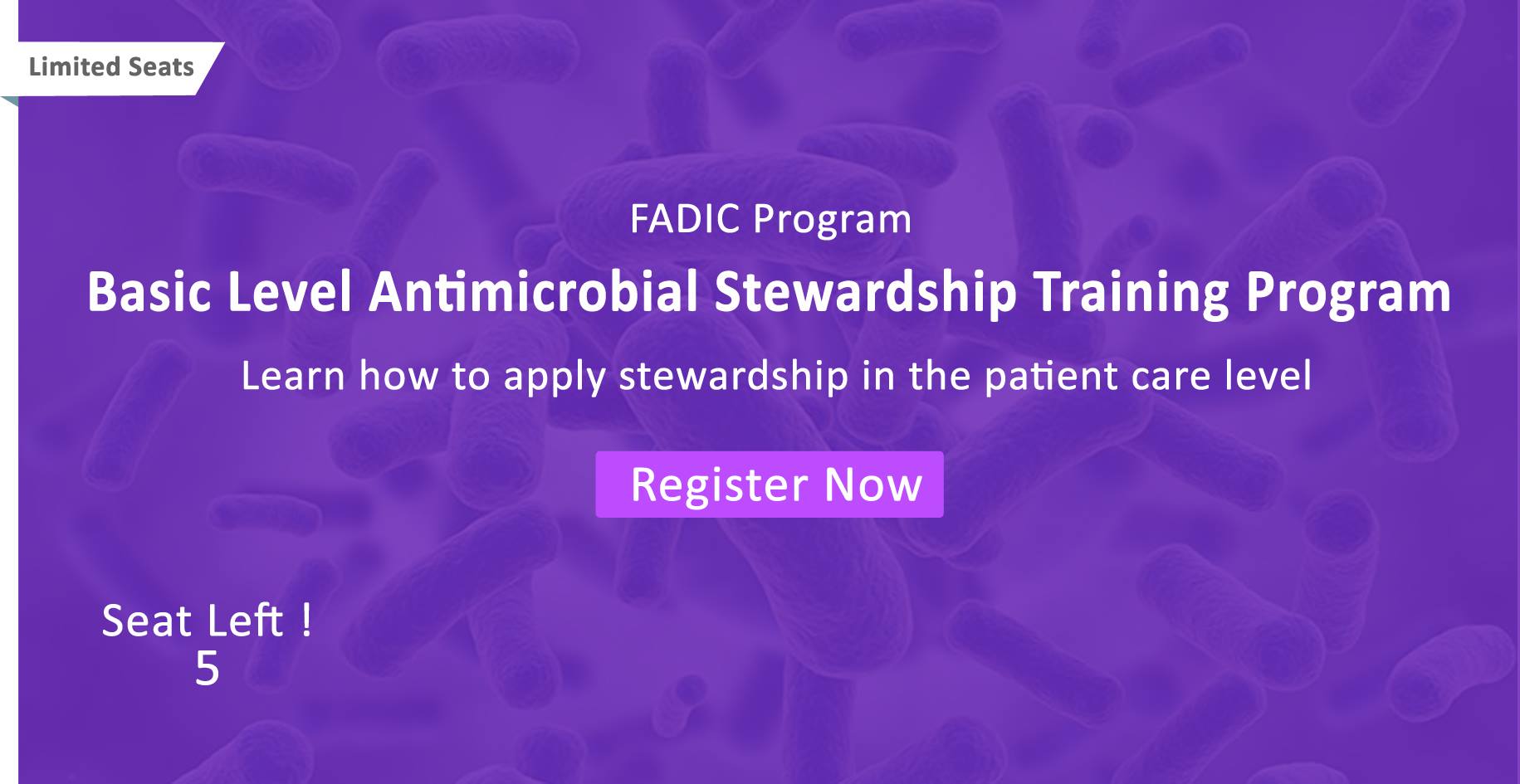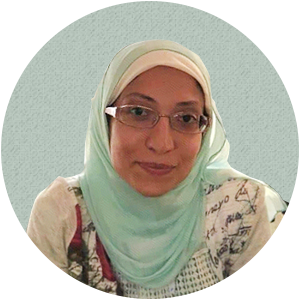
Why Take Basic Level Antimicrobial Stewardship Training Program?
This is to learn you all about Antimicrobials, microbiology, Pharmacokinetics, and Pharmacodynamics, and Infectious Diseases Treatment Guidelines in the patient care level.
Overview
Basic-Level Antimicrobial Stewardship Training Program
Program Description
- Antimicrobial stewardship is a coordinated program that promotes the appropriate use of antimicrobials (including antibiotics).
- It improves patient outcomes, reduces microbial resistance, and decreases the spread of infections caused by multidrug-resistant organisms.
- Misuse and overuse of antimicrobials are one of the world’s most pressing public health problems.
- Infectious organisms adapt to the antimicrobials designed to kill them, making the drugs ineffective.
- People infected with antimicrobial-resistant organisms are more likely to have longer, more expensive hospital stays, and may be more likely to die as a result of an infection.
- From here FADIC starts the Antimicrobial Stewardship Training Program, to learn you all about stewardship and its implementation on the patient care level.
What You Will Learn
1.Microbiology of Bacteria
- Explain the Gram‐stain & morphology of various bacteria
- Discuss commensal flora in the body and where select organisms are pathogenic
- List agents with activity or should be considered for use against various organisms
- Discuss resistance issues associated with various organisms.
2. Clinical Pharmacology of Antimicrobials
- Explain the principals of anti-infective pharmacology
- Describe the classifications of anti-infectives including mechanisms of action, mechanisms of resistance, the spectrum of activity, infections commonly treated, adverse effects (most
common, very serious or unique), and drug interactions - Select and discuss the rationale for drugs of choice for various organisms.
3. Pharmacokinetics of Antimicrobial Agents
- Define the pharmacokinetics of Antimicrobials.
- Know the different pharmacokinetic parameters.
- Understand the effect of pharmacokinetic parameters on antimicrobial agents.
- Learn about the pharmacokinetics of special populations.
4. Pharmacodynamics of Antimicrobial Agents
- Understand the different pharmacodynamics parameters and their effect on drug dosing.
- To understand the difference between the different pharmacodynamic patterns of antimicrobial agents.
- Learn about the alternative dosing strategies used to optimize drug dosing.
- Know the understand synergism and antagonism of antimicrobial combinations.
5. Infectious Diseases Treatment Guidelines
- Design an appropriate treatment regimen, and the definitive treatment plan for management different infectious disease conditions, such as:
- Sepsis
- Upper Respiratory
- Lower Respiratory
- Skin, and Soft Tissue Infections
- GIT Infections
- Endocarditis
- Bone, and Joint Infections.
- Urinary Tract Infection
- Meningitis
- Intra-abdominal Infections
- Surgical Prophylaxis
- Intravascular Catheter‐Related Blood Stream Infections
6. All About Antifungals From Guidelines to Bedside
- Recognize the differences between yeasts, molds, and dimorphic fungi.
- Describe the classifications of antifungals.
- Select and discuss the rationale for drugs of choice for the various organism.
- Describe the clinical application of PK/PD parameters in daily clinical practice.
7. ASP application In community pharmacy
- To define how to implement stewardship in a community pharmacy
- Learn how to perform interventions for patients in order to slow resistance.
- Know how to educate the patients.
- Alert physician for any medication inappropriateness
- Describe the role of pharmacists in applying stewardship in community pharmacy.
Live Activities
Projects:
- Infectious Disease clinical case presentation.
- Antimicrobial Stewardship intervention into patient care level.
Webinars:
- Stewardship systematic thinking in infectious disease cases.
- Antimicrobial stewardship pharmacist-led strategies.
Finally, Learn How to start Antimicrobial Stewardship in any infectious disease case
Learn with the Best
Educators:
Dr. Rasha Abdelsalam
BCPS - AQ (ID), CPHQ, TQM (AUC),
Master & Diploma of clinical pharmacy.
Quantitative Research Certification.
Antimicrobial Stewardship Certification/SIDP.
Item Writing American Board of Infectious Disease.
Reviewer for PSAP ID 2018 Series

Dr. Rasha is a CEO of FADIC. She was in Tanta university hospital, Egypt. In 2013, she received TQM from American university, BCPS, CPHQ, and M.Sc. of Clinical Pharmacy. She received certification from SIDP. She obtained the add qualification from American board in infectious disease. Leaded MM CBAHI Saudi accreditation. Established stewardship committee, and implementation in MCH, Makkah, Saudi Arabia.
She shared in item exam writing for BCIDP Exam. She shared as a reviewer in infectious diseases PSAP. Authorship for published around 20 papers. One paper about vision of 2030 of general pharmaceutical department in Saudi Arabia. She received TLC certification from ACCP academy. Moreover, consultant on personal, professional, stewardship leadership, research. Share in strategic planning; hospital accreditation; and stewardship education.
Dr. Heba-t-Allah Matar
BCPS, M.Sc. Of Clinical Pharmacy
Clinical Pharmacy Diploma

Dr. Heba-t-Allah Matar has B.Sc. Of Pharmaceutical Sciences, Cairo University
in 2007, In 2014 she become BCPS, and subsequently M.Sc. Degree in Clinical Pharmacy. She become A Member of FADIC Since December 2014, and lecturer in Drug Information Program, Antimicrobial Stewardship Program, Patient Counselling, and Cardiology Updates Program. In 2017, she joined Mandour Medical Center. Then, become Drug Information Specialist in New Cairo Hospital Since November 2018.
Dr. Fatma Elzahraa Ahmed
BCPS, CPHQ, Master clinical pharmacy.Antimicrobial Stewardship Certification/SIDP

Fatma Elzahraa is a member in FADIC, where she has participated in different Programs as Clinical pharmacy lecturer (drug information program, patient counseling program, new cardiac updates course, antimicrobial stewardship program, and Evidence based medicine) for the last four years. Beside her participation as a speaker, She has experience as drug information Pharmacist. She is a frequent speaker at FADIC online conferences; she is a RPh in UAE. In 2018 June: Antimicrobial stewardship (SIDP), In 2017 May: Team STEPPS Master Trainer by (AHRQ), 2016 March: (CPHQ) by NAHQ, 2014 October: (BPCS), M.Sc. & Diploma of clinical pharmacy.
-
Introduction
- Meet the Educators
- What is Antimicrobial Stewardship Program ?
- The Introduction of Basic Level Antimicrobial Stewardship Program
-
Week 1: Microbiology Part 1
- Microbiology Introduction
- Workshop 1 – Microbiology Part 1
- Gram-Positive Vs. Gram-Negative Bacteria
- Minimum Inhibitory Concentration Interpretation
- Gram Positive >>Cocci >>Staphylococcus
- Gram Positive >> Cocci >> Streptococcus & Enterococcus
- Gram Negative >> Coccobacilli >> Haemophilus Influenzae, Neisseria Meningitidis
- Antimicrobial Stewardship Algorithms
-
Week 2 - Microbiology Part 2
- Workshop 2 – Microbiology Part 2
- Gram-Negative >> Bacilli >> Enterobacteriaceae
- Gram Negative>> Bacilli >> Non Fermenters
- Atypical Organisms >> Chlamydia, Mycoplasma, and Legionella
- Anaerobes Organisms
-
Week 3 - Clinical Pharmacology Part 1
- Clinical Pharmacology of Penicillin
- Clinical Pharmacology – Polymixens
- Clinical Pharmacology of Cephalosporines
- Project 3 Workshop of Pharmacology
-
Week 4 - Clinical Pharmacology Part 2
- Clinical Pharmacology of Aminoglycosides
- Clinical Pharmacology of Fluoroquinolones
- Clinical Pharmacology of Tetracyclines
- Workshop 4 – Pharmacology Part 2
- Clinical Pharmacology of Sulfonamides
-
Week 5 - Pharmacokinetics
- Basic Definitions of Pharmacokinetics
- Pharmacokinetics of Antimicrobial in a Special Populations
- Project 5 Workshop of Pharmacokinetics
-
Week 6 - Pharmacodynamics
- Pharmacodynamics Basic Definitions
- Application of Antimicrobial Pharmacodynamics
- Antibiotics Combinations Synergism Vs. Antagonism
- Workshop 6 – Pharmacodynamics
-
Week 7 - Respiratory Tract Infection
- Upper Respiratory Tract Infection “URTIs”
- Lower Respiratory Tract Infection “CAP”
- Lower Respiratory Tract Infection “HAP and VAP”
- Workshop 7 – Upper & Lower Respiratory Tract Infection
-
Week 8 - UTI, CRBSI, and SSTI
- Urinary Tract Infections
- Intravascular Catheter‐Related Blood Stream Infections
- Skin, and Soft Tissue Infections
- Workshop 8 – CRBI, UTI, SSTI
-
Week 9 - Endocarditis, and Surgical Prophylaxis
- Management of Infective Endocarditis
- Antimicrobial Surgical Prophylaxis and SSI
- Workshop 9 – Endocarditis, and Surgical Prophylaxis
-
Week 10 - Antifungals Pharmacology, Microbiology, and PK
- All About Antifungals From Guidelines to Bedside
- Clinical Pharmacology of Anti-Fungi
- Anti-fungal Pharmacokinetics and Pharmacodynamics
- Management of Invasive Candidiasis
- Workshop 10 of Anti-Fungal
-
Webinars
- Antimicrobial Stewardship Symposium
-
Recap
- Recap

 Log in
Log in Sign up
Sign up



